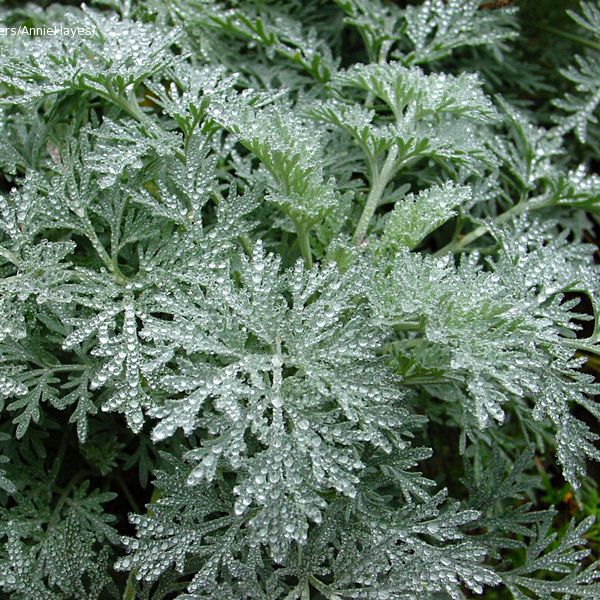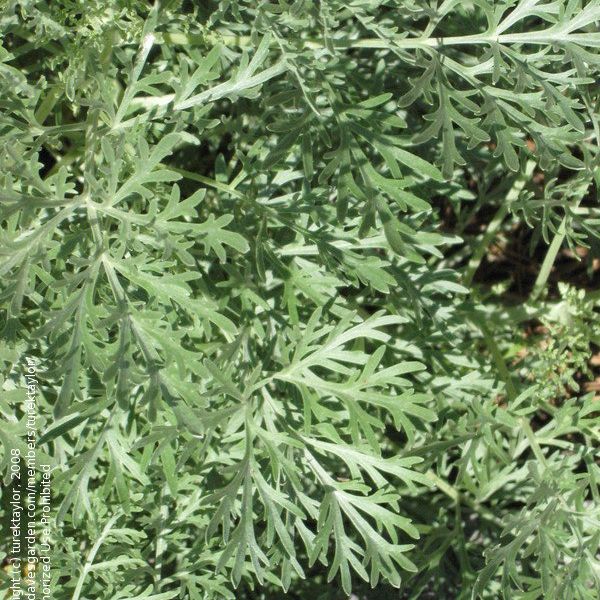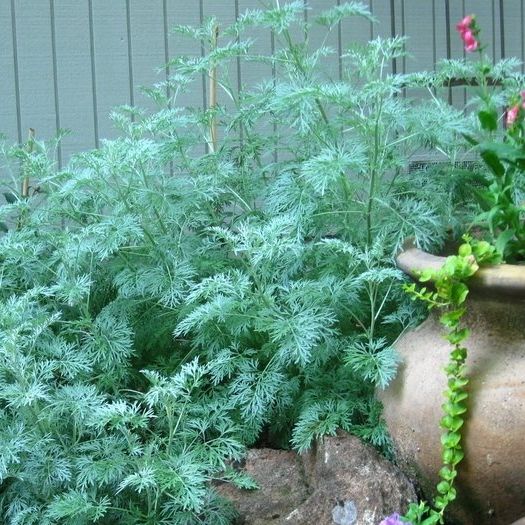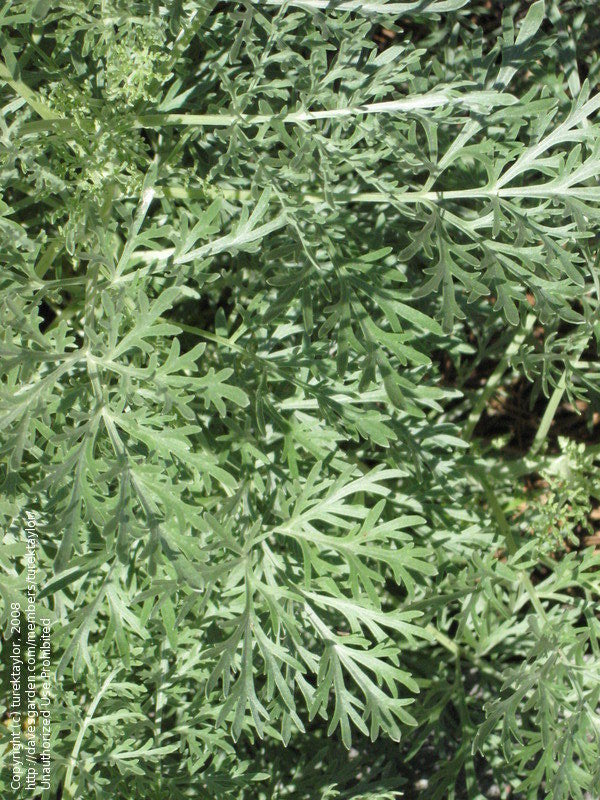Artemisia Absinthium - Wormwood
Artemisia Absinthium - Wormwood
Wormwood
Couldn't load pickup availability
Artemisia Absinthium – Wormwood
Unique Silver-Green Foliage with Aromatic Qualities
Artemisia absinthium, commonly known as Wormwood, is a striking perennial celebrated for its silvery-green, finely dissected foliage that provides a dramatic contrast in the garden. The plant’s distinctive, aromatic leaves exude a characteristic herbal scent when touched, making it a standout feature in herb gardens, perennial borders, and wildlife gardens. Its unique appearance, paired with its strong fragrance, adds texture and depth to garden displays.
Resilient and Hardy – Thrives in Poor, Well-Drained Soil
Wormwood is highly resilient and thrives in poor, well-drained soils, making it an excellent choice for xeriscaping or low-maintenance gardens. It tolerates dry conditions and is well-suited to areas with full sun. Once established, Artemisia absinthium is drought-tolerant, and its ability to flourish in lean soils makes it perfect for rock gardens or mediterranean-style plantings.
Supports Biodiversity and Repels Pests
In addition to its striking aesthetic and aromatic qualities, Wormwood is also a pest-repellent plant. Its distinctive fragrance helps deter insects, including mosquitoes and aphids, making it a natural pest control solution in your garden. Artemisia absinthium is also beneficial for attracting pollinators such as bees and butterflies, which are drawn to its unique scent and foliage.
Ideal for Herb Gardens, Border Edging & Drought-Tolerant Plantings
Artemisia absinthium’s distinctive form and strong fragrance make it an ideal addition to herb gardens, border edgings, or drought-tolerant planting schemes. It pairs well with other aromatic herbs such as Thyme, Oregano, and Lavender, as well as sun-loving perennials like Echinacea and Coreopsis. Its ability to thrive in poor soils and withstand dry conditions makes it a perfect choice for low-maintenance garden designs.
Plant Features:🌬️ Silver Foliage: Artemisia Absinthium boasts deeply incised, silvery-grey leaves that provide a striking contrast and texture to any garden setting.
🌼 Subtle Flowering: In mid-summer, Wormwood produces small, yellow-green flowers that add a subtle hint of colour and interest.
🐜 Natural Pest Repellent: The potent aromatic oils in Wormwood are known to repel a variety of pests, including mice, slugs, moths, fleas, earwigs and ants, making it an invaluable companion plant ally in organic pest management.
☀️ Drought-Tolerant: Once established, Artemisia Absinthium is incredibly drought-resistant, thriving in well-draining soils and full sun, perfect for xeriscaping and low-water gardens.
💧 Low Maintenance: Wormwood's resilience and adaptability make it an ideal choice for gardeners seeking beauty without the high maintenance.
🏡 Versatile Garden Use: Its unique texture and colour make it an excellent choice for borders, herb gardens, and as a striking foliage contrast in mixed plantings.
🌍 Grown with Care: Our Artemisia Absinthium is cultivated using sustainable practices, ensuring a healthy start without reliance on synthetic chemicals, preserving its natural potency and benefits.
🏡 Garden Uses:
Incorporate into herb or medicinal gardens for its historical significance and utility.
Use as a border plant or in rock gardens for its striking foliage and drought tolerance.
Plant near vegetable beds or fruit trees as a natural pest deterrent, enhancing the health and productivity of your garden.
Pair with brightly coloured flowers or plants to create dramatic visual contrasts.
Do not use around carrot family plants as it is thought to give off auxins which stunt their growth.
🌱 How to Care for Artemisia Absinthium:
- Plant in well-draining soil in a location that receives full sun to partial shade.
- Water moderately until established, then reduce frequency, as Wormwood prefers drier conditions.
- Prune in early spring or late fall to maintain shape and encourage healthy, dense foliage.
- No need for frequent fertilisation; a light application of compost in the spring is sufficient.
🐜 Pest-Repellent Qualities
Wormwood's natural pest-repellent properties make it an excellent choice for gardeners looking to minimise reliance on chemical pesticides, fostering a healthier, more sustainable garden ecosystem.
🚫 Is Artemisia Absinthium Safe for Pets and People?
While Artemisia Absinthium is beneficial for gardens, it's important to note that it should be used with caution around pets and people due to its potent toxic oils and compounds. 🐾🌿
🌱 Sustainably Cultivated Wormwood
Our wormwood plants are lovingly tended in my garden nursery, following eco-friendly practices. We propagate them in wooden seed trays, then transfer them to wood fibre pots, and finally plant them in wooden containers filled with Soil Association certified peat-free organic compost. This meticulous approach ensures robust, non-pot-bound, and disease-resistant wormwood plants. I avoid synthetic fertilisers and pesticides, preserving their natural defences. When you order wormwood from our online shop, rest assured it won’t harm your local ecosystem.
🌿 Eco-Conscious Packaging and Delivery
When you purchase wormwood from us, we take care of the environment too. Your wormwood plants are either shipped in wood fibre pots, wrapped in truly home-biodegradable natural material, or harvested from wooden troughs. No unnecessary waste or fuss—simply pop them straight into the ground without removing anything. And for delivery, we carbon-offset our postage with Royal Mail, which already boasts the lowest carbon footprint per parcel delivered
Plant care guide
Plant care guide
How do you plant perennials?
Dig a hole slightly larger than the woodfibre pot or balled rootball size, but no deeper. If it is a plant that likes to stay on the drier side (such as lavender), make the hole slightly shallower than the root ball so the surface of the rootball sits proud of the ground and use organic matter around the plant to stop water pooling on the base of the plant.
Water the hole and if the woodfibre pot or rootball doesn't seem moist pre-soak the pot or hessian contained rootball until it is saturated (no more bubbles rise to the surface).
There is normally no need to add compost to the hole if you have an established garden with healthy plants already growing. If you have a newbuild property or poor growth to existing plans chances are that your whole flowerbed needs improving with organic matter.
Place the pot or rootball in the hole. You can remove the hessian sacking it came in, or just remove the staple/twine and open the top once it's in the ground so the plant is free. The roots will easily grow through and the hessian will decompose, as will the woodfibre pots. Back fill the surrounding area with the dug soil. Do not firm the soil down hard! Roots need air and water and hard compacted soil prevents them from getting both.
Once planted water the plant in well and then water again whenever the soil starts to dry out under the surface, being careful not to overwater.
Mulching with something like woodchips around the plant after watering will help the soil to retain the moisture in hot weather. The perennial's foliage will die off in the winter and the plant will regrow through the mulch in the spring!
When to plant perennials in the UK?
Perennial plants can be planted out in the garden or in pots from spring, through the summer, to autumn. During dry weather and especially during the summer much closer attention needs to be given to watering in the first year.
If planting in hot weather, cut the foliage and flowers back. Your new plant will not be taking up much water until established so may struggle if the leaves lose more water than the roots can absorb. For the strongest result do not allow to flower or at least to set seed in the first year.
Where to plant perennials?
Check the plant info at the bottom of the page for the best place to position your new plant. If it prefers sun and you plant it in a north facing flowerbed next to a wall don't expect it to thrive or flower.
Pay attention to the soil. if it is heavy clay, incorporate organic matter such as compost to the soil before planting your perennial, preferably to the whole flowerbed. This will improve the soil by buffering it's water and nutrient holding ability. It is preferable to not just plonk compost in the bottom of the hole as it will not improve the overall condition of the soil surrounding your new plant. Do not add a layer of gravel or grit to the bottom of the hole as this will merely cause the perched water table to be higher. It will not improve drainage.
How do you care for perennial plants?
Cut back untidy foliage in the spring (you can leave the clippings on the flower bed to allow the nutrients to recycle into the soil). Divide every 3 to 5 years as the centre dies out and replant your extra plants! Perennials come back every year. Some are longer living than others.
Should perennials be fertilised?
The vast majority of garden soils contain plenty of nutrients, but if your garden is in a newly built development there is a good chance a thin layer of topsoil has been added on top of infertile subsoil. if that is the case, compost, soil improver or well rotted manure can be spread on the flower bed and dug in, or alternatively for those short of time or energy, organic fertiliser such as our own special organic mix of bone meal, hoof and horn and vinaase that is an organic, sustainable alternative to the John Innes formula, can be sprinkled around the plant with some compost added to the planting hole.
Delivery £5 flat rate or FREE over £50 spend.
Delivery £5 flat rate or FREE over £50 spend.
I charge a flat rate of £5 for postage and packaging to all of Britain, including the Highlands and the Isle of Man, with free delivery for orders over £50. We are unable to send plants to Northern Ireland.
I use Royal Mail for our deliveries as they have the lowest carbon footprint per parcel delivered in the UK and actually tend to look after parcels rather than just chucking them over the nearest fence! This ensures that your plants will have the best care possible.
Please have a Safe Place set up if possible so your plants are not returned to the sorting office if no one is home to accept the delivery.
I try to dispatch plants twice a week and you will receive updates by text or email. In cases of extreme weather or if Royal Mail has a hiccup the delivery may be delayed but we'll keep you in the loop.
I'm unable to deliver to the Channel Islands or Northern Ireland.
The LAWNMOWER Guarantee
The LAWNMOWER Guarantee
Healthy plants & happy customers
Your plant will only be dispatched if I'm happy it is healthy. The nature of growing the plants in large troughs means that the root system will be trimmed before they are balled in hessian, and therefore, depending on the time of year, the top growth may also be trimmed to make sure the roots are able to supply the water and nutrients your new plant requires.
Pruning encourages new growth and this applies to roots as well so a pruned plant actually results in a stronger plant.
The LAWNMOWER guarantee.
If you're not happy with your plants for any reason, even if you've run them over with your lawnmower, just pop them in a box (the plants, not the mower!) and post them back to us within 1 year for a replacement or refund.
This does not affect your statutory rights.
For full details check out the Refunds and Returns Policy.
Sustainability
Sustainability
Eco-friendly business
Fed up with plants grown in plastic pots which are doused in herbicides and sprayed with synthetic chemicals by big nurseries who merrily burn through finite resources, fly plants in from abroad on jet planes, irresponsibly use peat and coir, kill any insect nearby with non-selective pesticides and generally only think of the bottom line?
So are we!
How we grow plants sustainably
Our plants are started in coldframes or inside our house, grown-on woodfibre pots or in reclaimed wooden troughs which are then carefully harvested and balled and burlapped (hessian wrap securing the rootball), before packing plastic free in a eco cardboard box from a certified B-corp carbon neutral supplier. Some plants are grown in 8cm woodfibre pots.
Sustainable and organic compost & fertiliser
Our Soil Association certified organic compost is bought in bulk without plastic bags from Dalefoot Compost, and consists of sheep wool, bracken and comfrey. This naturally feeds the plants for 12 months. If supplemental feeding is required we only use our own special blend of organic fertilisers (bone meal, hoof & horn and vinaase) which have been processed with solar energy.
Carbon Neutral business
The small amount of electricity we use is from renewable sources and we irrigate our plants with stored water we have harvested. Plus, we are using our house and land for more than one purpose, preventing further land use and utilising the sunk carbon cost of the building rather than creating more.
We have partnered with Carbon Neutral Britain to offset our emissions, and recognise that we are not in control of all parts of the supply chain so have fully offset scopes 1, 2 and 3 to take that in to account - so that's all emissions connected to our business, from the farts coming out of the back of the sheep, to the carbon dioxide from the delivery van outside your door.
We don't just offset and carry on, ALL the decisions we make work to reduce emissions - for instance we use Royal Mail to post our plants as they have by far the lowest carbon footprint per parcel delivered in the UK.
Artemisa Absinthium








